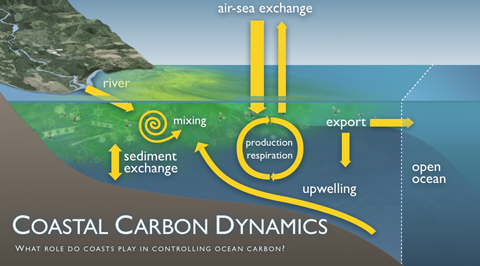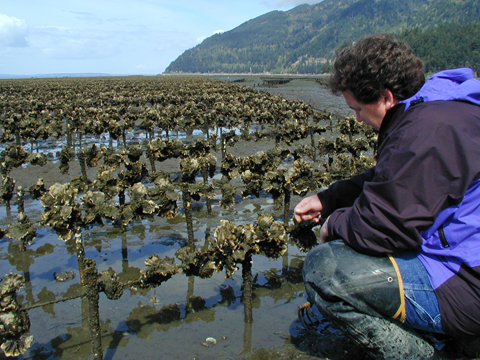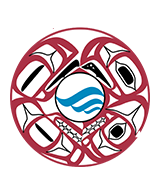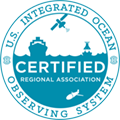Ocean Acidification
The marine waters of the Pacific Northwest are particularly vulnerable to ocean acidification. Regional marine processes including coastal upwelling exacerbate the acidifying effects of global carbon dioxide emissions. Coastal upwelling brings deep ocean water, which is rich in carbon dioxide and low in pH, up into the coastal zone. This upwelled water has spent decades circulating deep in the ocean, out of contact with the atmosphere for 30 to 50 years. This means that the waters currently upwelled onto the coast of the Pacific Northwest reflect the atmospheric carbon dioxide concentrations of the 1970s and 1980s. We will continue to see more acidifying conditions coming from upwelled waters into the future.

PMEL/NOAA
Other local factors that include runoff of nutrients from land, and local emissions of carbon dioxide, nitrogen oxides, and sulfur oxides, which are absorbed by seawater from the atmosphere, also impact the chemistry of the waters of the Pacific Northwest. The relative importance of these local factors varies by location. For example, acidification along the outer coast of Washington and Puget Sound is strongly influenced by coastal upwelling while acidification in shallow estuaries, including those in Puget Sound, may be influenced more by run off from fresh water sources (which are naturally low in pH) that are carrying nutrients from human and natural sources.

Puget Sound Partnership
Oyster growing in Samish Bay, Puget Sound
Shellfish along the West Coast is an $111 million industry, supplying 1000s of jobs in Oregon and Washington. Less than a decade ago, shellfish hatcheries in Oregon and Washington, essential to shellfish growers all along the West Coast, were on the verge of collapse. In 2012, scientists in Oregon found evidence that higher levels of carbon dioxide in the Pacific Ocean were responsible for the failure of oyster larvae to survive in 2005 at Whiskey Creek Shellfish Hatchery on Netarts Bay (Barton et al, 2012). Federal and state investments in monitoring of coastal seawater have helped to provide shellfish hatchery managers with real-time data on the seawater coming into their hatcheries. The data provide an early warning system, signaling the approach of cold, acidified seawater one to two days before it arrives in the sensitive coastal waters where shellfish larvae are cultivated. The data help hatchery managers schedule production when water quality is good, anticipate the need to buffer or adjust the chemistry of the water coming into their hatcheries, and avoid wasting valuable energy and other resources it water quality is poor.
Additional Resources
20 Facts About Ocean Acidification
Ocean Acidification in the Pacific Northwest: The Facts
This fact sheet summarizes our growing understanding of the causes and consequences of ocean acidification in the Pacific Northwest marine waters.
NOAA Pacific Marine Environmental Lab Carbon Program
NOAA Ocean Acidification Program
NOAA Northwest Fisheries Science Center
Washington State Blue Ribbon Panel on Ocean Acidification
Scientific Summary of Ocean Acidification in Washington State Marine Waters
West Coast Ocean Acidification and Hypoxia Science Panel
California Current Acidification Network (C-CAN)
Ocean Acidification Around the World
An interactive tool designed to make ocean acidification understandable by tracking emerging science and providing updates on what is occurring and where.
Washington Ocean Acidification Center
Ocean Acidification.Net
An informational website to bring information on ocean acidification to scientists, policymakers, and the public. Maintained by the International Geosphere-Biosphere Programme (IGBP).
NANOOS and the Shellfish Industry
A Senior Biologist at the Pacific Shellfish Institute describes how near-real time water quality data is used to inform shellfish growers and minimize larval mortalities.
IOOS Pacific Region Ocean Acidification
Ocean Technology Transition Project
NANOOS and its partners have been awarded a grant to improve OA observing capability along the U.S. west coast.
Related NANOOS Products
NANOOS Visualization System (NVS)
NVS Shellfish Growers App
NVS Data Explorer App
NVS Salish Cruise App
Related Videos
NOAA IOOS Video on Ocean Acidification
Washington Ocean Acidification Center
University of Washington Applied Physics Laboratory Video on the Washington Ocean Acidification Center and NANOOS
Acidity on the Halfshell
A five minute presentation by Libby Jewett of NOAA OAP.
Ocean Acidification in Puget Sound
Produced by students from the Suquamish Tribal Early College High School.
The Other CO2 Problem
Animation video by Ridgeway School students, Plymouth, UK.
Tracking an Ocean of Carbon
Narrated by Dr. Chris Sabine.
Acid Ocean
A short BBC Newsnight film on the impact of CO2 on the Ocean.
| National Observing System Partners Alliance for Coastal Technologies (ACT) Southeastern Universities Research Association (SURA) Integrated Ocean Observing System IOOS | |||||||

